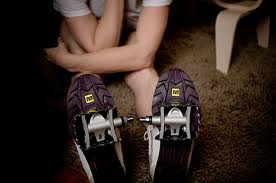
If you are a cyclist or if you have had the chance to be around many cyclists, you have probably heard your fair share of stories of cyclists who forget to clip out of their pedals and fall down. Every cyclist who has switched from flat, platform pedals to clipless pedals has experienced that moment when they came to a stop and forgot that they were attached to the bike. The result: a quick fall to the ground that is more embarrassing than it is painful.
What Does it Mean to “Ride Clipless?”
The cyclist gear provider, Wheelworld.com, defines a clipless riding system as:
“A system comprised of special pedals and cleats, devices included with the pedals that attach to the soles of clipless cycling shoes.” This means that you need to select pedals and shoes in order to upgrade to a clipless system.
Once you have the cleats bolted to your shoes and the clipless pedals on your bicycle, you simply put on your new shoes and step on the pedals to click your feet securely in place (most systems make a “click” when you’re locked in). Once engaged, your feet are connected to the pedals for optimum efficiency. And your feet won’t come off the pedals unless you want them to. To get out, you swing your heels to the outside as if you’re getting ready to put your feet down, and the pedals release.”
So Why Use Clipless Pedals?
Clipless pedals, as shown in the picture above, allow a rider’s shoes to be attached to the pedal itself. Bikeline.com states:
Borrowed from skiing technology, these trick pedals make you simultaneously more efficient by providing a better foot-to pedal connection, and more safe by offering almost instant foot entry and release. We recommend clipless pedals for road and mountain biking and everything from recreational riding to commuting and racing. They’re also great for Spinning classes.
Because your feet are locked into the pedals when riding, you’ll have more power throughout the pedal stroke and while accelerating and climbing. Clipless pedals also give you more control by letting you use your feet for maneuvers such as hopping pavement cracks, railroad tracks and more exciting obstacles if you’re riding off road. Plus, because you can get in and out so quickly, you’re more apt to get your feet down and land safely should you need to dismount quickly.
Something to Remember
Whether you decide to ride clipless or not, make sure that you know the rules of the road for cyclists. By clicking on the link, you can receive a free book on bicycle safety laws in Utah from Christensen and Hymas. Once you know the rules for your state and county, research what systems work best for you and then practice in a parking lot or away from traffic. Practicing on a clipless system before you get on the road will prevent serious injuries with other motorists and cyclists that could occur on other roads.
For more information about whether or not a clipless system is good for you, visit REI’s expert advice page.
Photo By: Missy S.
